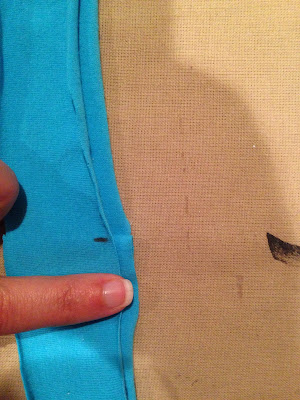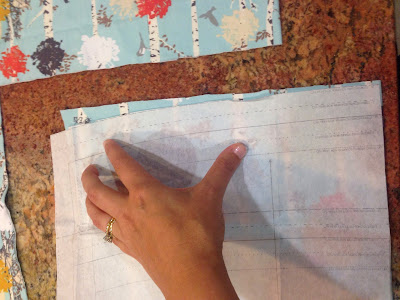The Penelope by Modkid
If you have any questions, suggestions, or tips to share;
please make sure to post them on our Facebook group. Also, if you would like to see any of the
images posted in this blog larger, just click on them. It
might be helpful in some steps.
Please
read the Penelope pattern directions all the way through before you
begin. It's
probably a good idea to read through this lesson once before you
begin also.
Hello everyone! Welcome to day one of the Penelope Sew Along! I am Sarah and I blog over at BlogsLikeAMother. I will be hosting the sew along and hopefully giving you a few tips you can use along the way.
It
is always exciting to start on a project for myself, although if I were
honest, I'd say exciting mixed with a little trepidation. So often
when I sew for myself I have a great plan in place, but it doesn't turn
out "just so" and I end up not wearing it. Well, never fear with this
one ladies! This is super easy AND flattering and you will not be sorry!
So let's get started...
Today we are doing our fabric prep and cutting.
A.The first step is fabric prep.
I
always wash my fabric before I use it. Always. In fact, I put it in
the wash as soon as I get it and before I put it away (who are we
kidding, I mean before I add it to the stacks around my sewing room!)
That way, I am always ready when sewing inspiration strikes. With
knits, it is especially important that you prewash because they tend to
shrink up a bit. So I would highly encourage you to wash your fabrics
before you get started.
If you haven't washed your fabrics, let's do that now.
B. While
the fabric is washing, let's get our pattern ready.
This is a paper
pattern, so no printing and cutting required! You will need to decide
what length you want to do and the size you want to make. I went with my
measurements and found the pattern to be very true to size.
When
I use paper patterns, I will often use freezer paper to trace out my
pattern. That way, if I want to make another on in a different size, I
haven't cut away those sizes. On this one, I decided to just cut out my
size. I do not sew for other people, so I feel pretty confident this
is the only size I will need to make out of this pattern. If you would
like to do the freezer paper method and are not sure how to do it just follow along. If you are not going to use freezer paper skip down to step 2 below.
1. Creating Freezer Paper Pattern Pieces
Hi everyone. This is Danielle and I also made the Penelope. As you might already know, I LOVE freezer paper so I went ahead and used it to trace my Penelope.
First I fussy cut around all of my pattern pieces.
Then, I ironed out the pattern pieces to make sure they were smooth.
Next, I rolled out my freezer paper to cover my pattern. As you can see my freezer paper wasn't wide enough to cover the whole pattern.
Since my freezer paper wasn't wide enough I used a scrap piece to lay over the arm.
I taped the extra piece down with masking tape. You don't want to use scotch tape because if you accidentally hit it with your iron it will melt.
Using a Sharpie marker trace over all of the lines and markings. Make sure to write all of the information on your freezer paper pattern pieces.
When I have everything traced I then fussy cut around my freezer paper pattern pieces.
To use your freezer paper pattern pieces you simply lay the
paper, shiny side down onto your fabric. Take your
iron and iron over the
pattern piece.
DO NOT touch the iron to the glossy side of your freezer paper! It will melt and make a mess of your iron. The freezer paper will temporarily stick to your fabric making it super easy to cut your pieces out. You will want to skip over
ironing where you have your masking tape. If you iron touches the
masking tape it will not instantly melt, but you don't really want to
iron back and forth over it either. Do iron the rest of the pattern
area onto your fabric though.
Now, back to Sarah!
2. Cutting out your fabric.
If
you are using the regular length or the dress length, go ahead and
select your size and cut it out using your preferred method. If you
want to alter it to a tunic length, this is how I did that.
Note: The Penelope Plus pattern does have a cutting line for a long tunic length on the pattern pieces already.
First
I measured how long I wanted it from my underarm to hem. I find the
underarm to hem measurement is easier to do when I am measuring myself,
but you could certainly do the center back or center front measurement
if you want. I marked that length on my pattern pieces. Then I cut out
the dress length pattern.
Once
my dress length pattern was cut out, I folded the pattern piece at my
measured tunic length and laid it out on the fabric.
I
cut along the straight edge of the bottom of the pattern (along, but
not through the fold) and just slightly past the folded edge.
The
I unfolded my pattern piece (so that I did not cut into it and could
see the pattern piece) and cut the rest of the piece out.
Once
the piece was cut out, I aligned the bottom of the dress piece (it is
slightly curved) with the straight edge I cut along the bottom of the
tunic. Since the curved hem line is a cute feature of the pattern, I
wanted to preserve that. Lining up the folded corner of the cut piece
with the pattern piece, I cut along the original curved hem line.
You
will notice that the piece does not line up on the side opposite of the
fold. That is fine! It is because the hem of the dress is wider than
the tunic length will be. But it still gives a nice curved hem for the
tunic.
I
repeated that process for the other piece and cut out my neck band. If
you are doing a ruffle, you will want to cut that out as well.
And then you are done for Day 1! Not so bad, right? Come join us for Day 2 and we will sew this right up!
* If you would like to enter the prize drawing, please make sure you submit a picture of your completed lesson one to the Facebook Album by 12:00 noon CT, Thursday, October 30th. Also, if you have any questions the Facebook Group is a great place to ask.
See you soon!
Sarah

























































